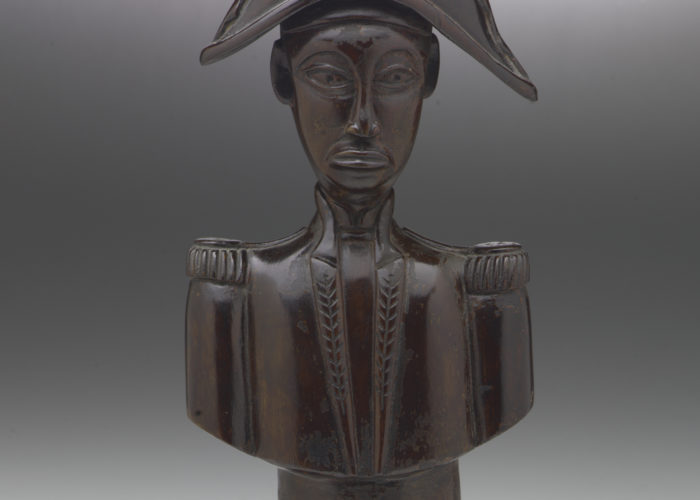Bust of Jean-Jaques Dessalines (1758 – 1806)
Theme: Revolutionary ideas, The arts in the Age of Revolution, Haitian revolution (1791 - 1804), Challenging slavery: abolition and opposition, French revolutionary and Napoleonic wars (1792-1815), War and the international order, Trade, tariffs and taxes
Jean-Jacques Dessalines (1758 – 1806) was born into slavery in St Domingue (now Haiti) on the Caribbean island of Hispaniola. Following a mass uprising of enslaved people of African origin – the only successful slave revolt in history – and a series of bloody battles and reprisals, Dessalines eventually became the first ruler of Haiti, the world’s first modern independent ‘black’ republic. The events in St Domingue became known as the Haitian Revolution.
By the 1790s, all the major islands in the Caribbean had long been occupied by European countries and populated by slaves, forced to work on plantations producing sugar, coffee, indigo and other commodities. Jean-Jacques Dessalines’ colony of birth, St Domingue, was France’s most profitable island. In 1791,Toussaint Louverture, who was also born into slavery but had been freed in 1776, led a revolutionary uprising against the island’s plantation owners and the cruel system of slavery.
Dessalines served under Louverture as one of the leaders of the uprising, meeting when both had enlisted to fight with the Spanish. Once the French proclaimed the abolition of slavery on the island in 1794, they fought together for Revolutionary France against the invading British and Spanish armies, and the pro-slavery supporters within Saint Domingue’s society. Napoleon Bonaparte’s rise to power in France changed the picture again, threatening the restoral of slavery throughout the French Caribbean. Dessalines resisted the new French invasion and united a coalition of former slaves and free people, rising to pre-eminence thanks to the capture of Louverture and his successful defensive campaign in 1802-3.
On New Year’s Day 1804, Dessalines proclaimed independence for the nation he christened Haiti – the world’s first ‘black’ republic and took the title Emperor Jacques I. His attempts to reenergise the flat-lining economy involved the recreation of systems of plantation labour, which generated much animosity and factionalism, as did his reliance on the army. While travelling to put down another rebellion from his disaffected people, Dessalines was assassinated in 1806.
The bust shows Dessalines in proud military costume, his bicorn hat denoting his status as a commander of Haitian forces and demonstrating the distinct military features of his power and hold over Haiti. The bust also shows the dual nature of Haitian society, while Dessalines is depicted in European military uniform, it is carved in a West African style, an important acknowledgement and reminder of Haiti’s heritage.
Did you know..?
Dessaline’s decision to name his new state Haiti, was a reference to the name used by the native Taino settlers, who lived on the island long before Christopher Columbus ‘discovered’ it in 1492.
Use our Classroom resources to investigate this object, and the themes of Challenging slavery, the Haitian revolution and Arts in the Age of Revolution further.
Highlights:
- Using objects, artworks and other sources to find out about the past
- Using museum collections as creative starters
- Enquiry: Abolition of the transatlantic slave trade
And much more…
Sources & acknowledgements
This object description and its related educational resources were researched and written by our team of historians and education specialists. For further information see the item’s home museum, gallery or archive, listed above.
- Enquiry Questions
-
Education overview
You can access a range of teachers resources related to this object and more on our education page.
Please also see our glossary of terms for more detailed explanations of the terms used.
-
Curatorial info
- Originating Museum: National Maritime Museum
- Accession Number: ZBA2482
- Production Date: 19th century
- Material: wood (varnished tropical hardwood)
- Creation Place: Caribbean, Haiti?
- Size: 370 mm
- Original record
-
Use this image
You can download this image for personal and educational use but please take note of the license type below.
- Rights Holder: National Maritime Museum, Greenwich, London: Michael Graham-Stewart Slavery Collection. Acquired with the assistance of the Heritage Lottery Fund
- License Type: All Rights Reserved
Find it here
This object is in the collection of Royal Museums Greenwich



